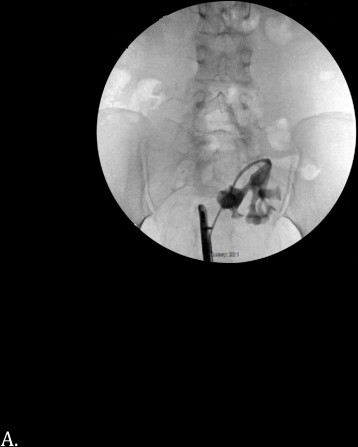Torsion and Inversion of Intraperitoneal Kidneys Manifesting as Acute Allograft Dysfunction – A Case Series
Saint Barnabas Medical Center, Livingston, NJ.
Meeting: 2018 American Transplant Congress
Abstract number: C169
Keywords: Graft function, Kidney transplantation, Renal failure, Renal thrombosis
Session Information
Session Name: Poster Session C: Kidney Technical
Session Type: Poster Session
Date: Monday, June 4, 2018
Session Time: 6:00pm-7:00pm
 Presentation Time: 6:00pm-7:00pm
Presentation Time: 6:00pm-7:00pm
Location: Hall 4EF
Torsion (rotation of kidney allograft around its vascular pedicle) or inversion (rotation of kidney graft around ureter) of intraperitoneal transplant kidney is a rare complication. We present here four cases of torsion or inversion which developed at varying time periods after transplantation.
Case 1
A 27 year old female with enteric-drained simultaneous pancreas and kidney (ED-SPK) transplant was admitted 7 months post-transplant with creatinine of 6.9 mg/dL. A transplant ultrasound revealed moderate hydronephrosis. Cystoscopy/retrograde ureteroscopy (CRU) revealed an inverted kidney. A nuclear renal scan demonstrated thrombosed allograft and needed transplant nephrectomy.
Case 2
A 36 year old male with history of multiple episodes of acute kidney injuries of unclear etiology post ED-SPK transplant was readmitted to the hospital at eight weeks with a serum creatinine of 7.3 mg/dL. CRU revealed an inverted kidney allograft. The patient had surgical correction and creatinine subsequently stabilized around 2 mg/dL.
Case 3
A 46 year old female 7 years post ED-SPK transplant was transferred from outside hospital for severe abdominal pain and a serum creatinine of 3.8 mg/dL (baseline 0.9 mg/dL). CT scan revealed mild hydronephrosis. Serum creatinine worsened to 5.2 mg/dL and developed anuria. Emergent exploration for suspicion of kidney allograft torsion revealed necrotic allograft and a transplant nephrectomy was performed.
Case 4
A 45 year old female with 2 failed kidney transplants, was admitted 18 months post intraperitoneal living donor kidney transplant with a serum creatinine of 4.7mg/dL. Transplant ultrasound showed moderate hydronephrosis. CRU revealed malrotation of the kidney allograft and redundant transplant ureter. Surgical correction of the inverted kidney allograft and ureteroureterostomy returned creatinine to baseline.
Our case series demonstrates the spectrum of manifestation of torsion and inversion of the intraperitoneally placed transplant kidneys. A high index of suspicion coupled with prompt surgical intervention can result in favorable outcomes. Close attention to intraperitoneal allograft position when radiological imaging are performed is warranted 
CITATION INFORMATION: Kandula P., Patel A., Bains S., Sun H. Torsion and Inversion of Intraperitoneal Kidneys Manifesting as Acute Allograft Dysfunction – A Case Series Am J Transplant. 2017;17 (suppl 3).
To cite this abstract in AMA style:
Kandula P, Patel A, Bains S, Sun H. Torsion and Inversion of Intraperitoneal Kidneys Manifesting as Acute Allograft Dysfunction – A Case Series [abstract]. https://atcmeetingabstracts.com/abstract/torsion-and-inversion-of-intraperitoneal-kidneys-manifesting-as-acute-allograft-dysfunction-a-case-series/. Accessed January 8, 2026.« Back to 2018 American Transplant Congress
